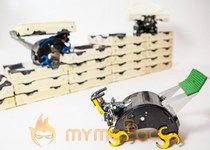Who would have thought the very same termites gnawing at our homes would be the inspiration for robots that can build new ones?
Robotic crews could build new structures on Earth or even Mars – and without human supervision, according to a Harvard research team that has developed a system called TERMES that consists only of robots cooperating and working with each other. They don’t need a foreman.
The researchers say the robots are capable of independently completing construction projects and theoretically will be able to build anything. They could be deployed to Mars to undertake construction tasks. Or in the event of a natural disaster like Hurricane Katrina, they could put down sandbag barriers before the storm arrives and help rebuild buildings when it’s gone.
A team of computer scientists and engineers from the Harvard School of Engineering and Applied Sciences and the Wyss Institute for Biologically Inspired Engineering has created an autonomous robotic construction crew that will be capable of doing all that and more. The researchers published the results of their four-year project in the most recent issue of Science.
The inspiration? Real termites
Designed to mimic the behavior of termites, the robots are resilient and employ collective intelligence.
In Africa, millions of the tiny insects work together to build very large mounds of soil for their underground nests, facing enormous challenges over the year or so of construction. Weather conditions will erode their project and many termites will die, meaning new termites are needed to carry on for them.
Harvard’s TERMES robot system achieves a similar team approach. Like termites, the robots can build complex, three-dimensional structures without a central command or prescribed roles.
When humans build structures, they tend to have a blueprint, a plan and a foreman to direct and supervise on site.
In insect colonies, on the other hand, there is no leader to instruct the others. Termites rely on “stigmergy,” where they intuitively understand how the other bugs are changing their environment and react without directly communicating.
Thanks to the Harvard team’s algorithms, the TERMES robots use a sort of stigmergy, too, allowing very large groups of robots to act as a colony. Their research demonstrates achievable distributable artificial intelligence.
How does it work?
On a practical level, this means that whether it’s a few robots or thousands, TERMES can work as a team, all using the same instructions.
Using foam bricks, the robots already can build complex structures like towers, castles and pyramids. They carry the bricks and then climb on them to add new ones. They build staircases to reach higher levels, adding bricks where they are needed. They even know how to add bricks without blocking important paths.
They can move forward and backward and turn in place. TERMES can pick up a brick, carry it and deposit it directly in front of itself. It can also climb up or down a step the height of one brick. Using only four basic sensors and three actuators, they can do it all.
In addition to keeping track of their location with respect to a first, or “seed” brick, TERMES can detect other bricks and robots in their immediate vicinity.
They obey predetermined traffic rules and orient themselves by circling the growing structure to find the seed brick.
Even if there is an unexpected structure change in the middle of construction, the TERMES team recovers and carries on.
Going it solo
Many alternative robot team systems rely on a central controller that can see and direct the whole process. Some systems rely on all the robots being able to constantly communicate with each other.
But with these approaches, the more robots and the larger the operational space, the more difficult it is to operate the systems. In remote or dangerous environments, a problem with the central controller could bring an entire construction project to a halt.
The advantage of the TERMES approach is that if it is deployed to support humanitarian operations, like helping the Army Corps of Engineers build replacement homes, each robot is able act on its own.







